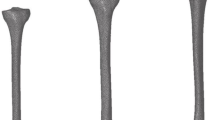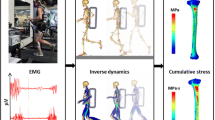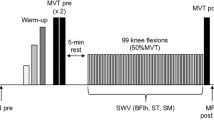Abstract
Muscular fatigue in the training athlete or military recruit has been hypothesized to cause increased bone strain that may contribute to the development of a stress fracture. Under normal circumstances, muscles exert a protective effect by contracting to reduce bending strains on cortical bone surfaces. In vivo strain studies in dogs show that muscle fatigue following strenuous exercise elevates bone strain and changes strain distribution. However, a similar experiment has yet to be performed in humans. The purpose of this work was to test the hypothesis in humans that strenuous fatiguing exercise causes an elevation in bone strain. It was also hypothesized that this elevation is greater in younger people than in older people due to the decline in muscle strength and endurance that normally occurs with age. To test these hypotheses, strain in the tibiae of seven human volunteers was measured during walking before and after a period of fatiguing exercise. Neither hypothesis was sustained. Post-hoc analysis of the strain data suggests that strain rate increases after fatigue with a greater increase in younger as opposed to older persons. Although not conclusive, this suggests that it is strain rate, rather than strain magnitude, that may be causal for stress fracture. © 1998 Biomedical Engineering Society.
PAC98: 8745Dr, 8745Bp, 0180+b
Similar content being viewed by others
REFERENCES
Burr, D. B., C. Milgrom, D. Fyhrie, M. Forwood, M. Nyska, A. Finestone, S. Hoshaw, E. Saiag, and A. Simkin. In vivomeasurement of human tibial strains during vigorous activity. Bone (N.Y.)18:405-410, 1996.
Carter, D. R., W. E. Caler, D. M. Spengler, and V. H. Frankel. Fatigue behavior of adult cortical bone: The influence of mean strain and strain range. Acta Orthop. Scand.52:481-490, 1981.
Carter, D. R., W. E. Caler, D. M. Spengler, and V. H. Frankel. Uniaxial fatigue of human cortical bone. The influence of tissue physical characteristics. J. Biomech.14:461- 470, 1981.
Carter, D. R., and W. E. Caler. Cycle-dependent and timedependent bone fracture with repeated loading. J. Biomech. Eng.105:166-170, 1983.
Carter, D. R., and W. E. Caler. A cumulative damage model for bone fracture. J. Orthop. Res.3:84-90, 1985.
Clarke, T. E., B. L. Cooper, C. L. Hamill, and D. E. Clark. The effect of varied stride rate upon shank deceleration in running. J. Sports Sci.3:41-49, 1985.
Friedl, K. E., and J. A. Nuovo. Factors associated with stress fracture in young army women: Indications for further research. Mil. Med.157:334-338, 1992.
Gollhofer, A., P. V. Moki, M. Miyashita, and O. Aura. Fatigue during stretch-shortening cycle exercise: Changes in mechanical performance of human skeletal muscle. Int. J. Sports Med.8:71-78, 1987.
Hausdorff, J. M., Z. Ladin, and J. Wei. Footswitch system for measurement of the temporal parameters of gait. J. Biomech.28:347-351, 1995.
Hill, D. B. Production and absorption of work by muscle. Science131:897-903, 1962.
Inman, V. T., H. J. Ralstrom, and F. Todd. Human Walking. New York: Williams and Wilkins, 1981.
James, S. L., B. T. Bates, and L. R. Osternig. Injuries to runners. Am. J. Sports Med.6:40-50, 1978.
Jones, B. H., J. McA. Harris, T. N. Vinh, and C. Rubin. Exercise-induced stress fractures and stress reactions of bone: Epidemiology, etiology, and classification. Exercise Sport Sci. Rev.17:379-422, 1989.
Keller, T. S., J. D. Lovin, D. M. Spengler, and D. R. Carter. Fatigue of immature baboon cortical bone. J. Biomech.18:297-304, 1985.
Lanyon, L. E., W. G. Hampson, A. E. Goodship, and J. S. Shah. Bone deformation recorded in vivo from strain gauges attached to the human tibial shaft. Acta Orthop. Scand.46:256-268, 1975.
Larsson, L., G. Grimby, and J. Karlsson. Muscle strength and speed of movement in relation to age and muscle morphology. J. Appl. Physiol.46:451-456, 1979.
Light, L. H., G. E. MacClellan, and L. Klenerman. Skeletal transients on heelstrike in normal walking with different footwear. J. Biomech.13:477-480, 1980.
Mann, R. A. Biomechanics of running. In: Symposium on Foot and Leg in Running Sports, edited by P. P. Mack. St. Louis: Mosby, 1982, pp. 1-29.
Margel-Robertson, D. and D. C. Smith. Compressive strength of mandibular bone as a function of microstructure and strain rate. J. Biomech.11:455-471, 1978.
McMahon, T. Muscles, Reflexes and Locomotion. Princeton, NJ: Princeton University Press, 1984.
McMahon, T. A., and P. R. Greene. The influence of track compliance on running. J. Biomech.12:893-904, 1979.
Milgrom, C., A. Finestone, N. Shlamkovitch, N. Rand, B. Lev, A. Simkin, and M. Wiener. Youth is a risk factor for stress fracture. J. Bone Jt. Surg., Br. Vol.76:20-22, 1994.
Mizrahi, J., and Z. Susak. Analysis of parameters affecting impact force attenuation during landing in human vertical free fall. Eng. Med. (Berlin)11:141 -147, 1982.
Nyland, J. A., R. Shapiro, R. L. Stine, T. S. Horn, and M. L. Ireland. Relationship of fatigued run and rapid stop to ground reaction forces, lower extremity kinematics, and muscle activation. J. Orthop. Sports Phys. Ther.20:132-137, 1994.
Pattin, C. A., W. E. Caler, and D. R. Carter. Cyclic mechanical property degradation during fatigue loading of cortical bone. J. Biomech.29:69-79, 1996.
Paul, I. L., M. Munro, P. J. Abernethy, S. R. Simon, E. L. Radin, and R. M. Rose. Musculo-skeletal shock absorption: Relative contribution of bone and soft tissues at various frequencies. J. Biomech.11:237-239, 1978.
Pauwels, F. Biomechanics of the locomotor apparatus. In: Contributions on the Functional Anatomy of the Locomotor Apparatus. Berlin: Springer-Verlag, 1980.
Radin, E. L. Nature of mechanical factors causing degeneration of joints in the hip. In: Proceedings of the 2nd Open Scientific Meeting of the Hip Society, 1974. St. Louis: Mosby, 1974, pp. 786-871.
Radin, E. L. Role of muscles in protecting athletes from injury. Acta Med. Scand. Suppl.711:143-147, 1986.
Radin, E. L., M. W. Whittle, K. H. Yang, et al.The heelstrike transient, its relationship with the angular velocity of the shank and the effects of quadriceps paralysis. In: 1986 Advances in Bioengineering, edited by S. A. Lantz and A. I. King. New York: The American Society of Mechanical Engineers, 1986.
Radin, E. L., K. Yang, C. Riegger, V. L. Kish, and J. J. O'Connor. Relationship of repetitive impulsive loading of the leg to knee pain. Paper presented at the 101st Annual Meeting of the American Orthopaedic Association, June 1988 (unpublished).
Rubin, C. T., and L. E. Lanyon. Limb mechanics as a function of speed and gait: A study of functional strains in the radius and tibia of horse and dog. J. Exp. Biol.101:187-211, 1982.
Schaffler, M. B., E. L. Radin, and D. B. Burr. Mechanical and morphological effects of strain rate on fatigue of compact bone. Bone (N.Y.)10:207-214, 1989.
Schaffler, M. B., E. L. Radin, and D. B. Burr. Long-term fatigue behavior of a compact bone at low strain magnitude. Bone (N.Y.)11:321-326, 1990.
Schultz, A. B., J. A. Ashton-Miller, and N. B. Alexander. What leads to age and gender differences in balance maintenance and recovery? Muscle and Nerve(Suppl.) 5:S60-S64 (1997).
Schwender, K. I., A. E. Mikesky, W. S. Holt, M. Peacock, and D. B. Burr. Differences in muscle and endurance and recovery between fallers and non fallers and between younger and older women. Eur. J. Sports Med.(submitted).
Simon, S. R., I. L. Paul, J. Mansour, J. Munro, P. J. Abernethy, and E. L. Radin. Peak dynamic force in human gait. J. Biomech.14:817-822, 1981.
Verbitsky, O., J. Mizrahi, A. Voloshin, J. Treiger, and E. Isakov. Shock absorption and fatigue in humans. J. Biomech.(submitted).
Wright, T. M., and W. C. Hayes. The fracture mechanics of fatigue crack propagation in compact bone. J. Biomed. Mater. Res. Symp.7:637-648, 1976.
Yoshikawa, T., S. Mori, A. J. Santiesteban, T. C. Sun, E. Hafstad, J. Chen, and D. B. Burr. The effects of muscle fatigue on bone strain. J. Exp. Biol.188:217-233, 1994.
Author information
Authors and Affiliations
Rights and permissions
About this article
Cite this article
Fyhrie, D.P., Milgrom, C., Hoshaw, S.J. et al. Effect of Fatiguing Exercise on Longitudinal Bone Strain as Related to Stress Fracture in Humans. Annals of Biomedical Engineering 26, 660–665 (1998). https://doi.org/10.1114/1.103
Issue Date:
DOI: https://doi.org/10.1114/1.103




